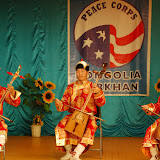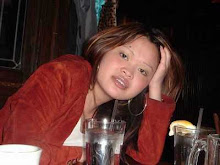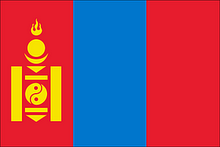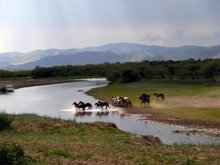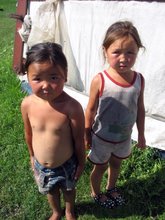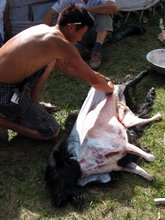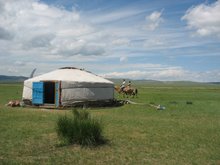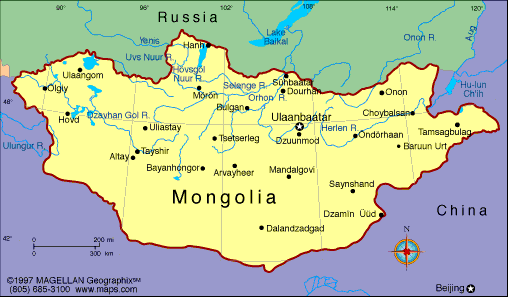One family trip was to Suhkbaatar’s grave and first work place: pictures below.
Burengiin Nuruu Mountain Range

History of the Peace Corps Program in Mongolia
Country Assignment
- Country: Mongolia (Outter)
- Program: Youth Development
- Job Title: Life Skills Trainer (also: English teacher, Child Caretaker, Fund Raiser, Events Organizer, and IT Trainer)
- Orientation (Staging in Atlanta, GA): May 31-June 2, 2007
- Pre-Service Training (in Darkhan and Sukhbaatar, Mongolia): June 3-August 18, 2007
- Dates of Service (in Darkhan at Sun Children formerly "Asian Child Foundation" - a non-profit, non-government Japanese funded orphanage of 37 Mongolian children opened since 8/25/2005): August 19, 2007- August 18, 2009
Location and Nature of the Job
CYD Volunteers are placed in provincial centers with population between 15,000 and 70,000. A few CYD Volunteers are placed in Ulaanbaatar, where the population is reaching 1 million. I will work with youth-focused NGOs, children’s centers, schools, and civil society organizations to address major challenges confronting Mongolian youth today, such as education, life skills, employability, and leadership. In addition, the work will involve workshops and presentations at schools and community agencies and will entail traveling to other outlying communities that have less access to information and training. Given the vast distances in Mongolia, these visits will often require overnight stays.
Tuesday, June 26, 2007
A Taste of Mongolian History: The Legend of Sukhbaatar
One family trip was to Suhkbaatar’s grave and first work place: pictures below.
Sunday, June 24, 2007
Saturday, June 23, 2007
A Mission to See Russia, Hiking
Pictures from that day are below:
.jpg)
.jpg)
.jpg)
Friday, June 15, 2007
Culture Observation: Naked Babies
Thursday, June 14, 2007
The Difficulties of the Mongolian Language

Tuesday, June 12, 2007
Host Family Description
My host dad is a telecom cable technician at the local post office. My host mom is a researcher at the nearby hospital; she has been working there for the past 27 years. My host parents are in their late-40s. I have three younger host siblings: two brothers and a sister. One brother is a recent college graduate of 23 who has moved back home in order to plan his next steps; a common move by young graduates in the States as well. The other brother is 19, attends college in UB and is working two jobs this summer for a little spending cash during the school year. My host sister is a sweet girly girl of 21 (her favorite color is pink, and she can’t go anywhere without her zebra-print heels). She, too, is a recent college graduate but her ambitions are higher; she will be going back to UB to pursue her MA and has plans of becoming a customs officer. Her ‘job’ this summer is to take care of me, a task that includes: meals at promptly 8:30am, 1:30pm and 7:30pm (times scheduled around my language and technical lessons at the nearby school) and Mongolian tutoring. My family seems wonderful and thoroughly accepting. My PST is off to a great start.
Monday, June 11, 2007
Unusual Pets
Sunday, June 10, 2007
Farewell Toilets: Heading Out to the Host Communities
Saturday, June 9, 2007
Arrival into Mongolia
I arrived in Ulaanbaatar (UB; the capital, translated as: Red Hero), Mongolia via a 27 hour layover in Seoul, Korea on June 4. The first night, our group of 48 Americans stayed in a tourist ger camp. The next morning was unreal: I woke up to blue skies, rolling hills, hawks, the smell of horses, and finally, the excited feeling of being in Mongolia. Lunch that day was with the US Ambassador to Mongolia, Ambassador Milton. Then we headed four hours via bus north to Darkhan (the 3rd largest city in the providence or aimag of Selenge, population 73,400), where we resided for a week for introductions and vaccination shots (16 in total;ouch) at a nearby school (pictures of the welcoming ceremony at the school are below). Afterwards, we were divided into three groups and headed off for our host communities (all located north of UB) till mid-August when we take our final LPIs (Language Proficiency Interviews), swear-in, and officially become PC (Peace Corps) volunteers. My host community is in Sukhbaatar (30 km from the Russian border). My host family are wonderful; they treat me like one of their own. Training is intense with 4 hours/5 days per week of Mongolian language classes and the other four hours per day is devoted to technical training. My biggest fear at this point is falling into the pit toilets...which I conveyed to the interim Country Director and she assures me that this has only happened once – but not in Mongolia. However, the girl survived unscathed. How this was suppose to comfort me, I don’t know.
Sunday, June 3, 2007
Friday, June 1, 2007
27 Hour Layover in Seoul, South Korea
pre-service training.
My training group is a large group of 48: four set of married couples, two middle-age gentlemen, and 38 mid-twenties youngsters – all here for a variety of reasons. They are a great bunch and I'm excited about the prospect of getting to know them in the next two years.
I'm not in Mongolia yet but I miss you all already. Below are how I spent my layover time in Korea.
2. Downtown Seoul, South Korea
3. Billiard advertisement in down Seoul
4. Gyeongbokgung, the main palace of the Joseon Dynasty; the Changing of the Guard
5. Buddhist temple, Seoul





Recommended Books on Mongolia
- “Dateline: An American Journalist in Nomad’s Land” by Michael Kohn, 2006.
- "Ghengis Khan and the Making of the Modern World” by Jack Weatherford, 2004.
- “Riding Windhorses” by Sarangerel, 2000.
- “Twentieth Century Mongolia” by Baabar, 1999.
Recommended Mongolian Movies
- The Story of the Weeping Camel (2004), Die Geschichte vom Weinenden Kamel
- Mongolian Ping Pong (2005), Lü cao di
Notable Articles on Mongolia
Informational Links
- Peace Corps - Mongolia
- International Calling Card (Cheap!)
- Current Mongolian News
- Current Weather Conditions in Ulannbaatar, Mongolia
- A Tour of Mongolia Through Photography
- History of Mongolia
- Mongolian Culture
- Mongolian Lanuage
- Weather and Climate In Mongolia
- Travel Guide to Mongolia
- Official Tourism Website of Mongolia
- Asia.com - Cheapest Airfare to Asia
- MIAT - Mongolian Airlines
- Currency Converter
- Entry and Visa Requirements






